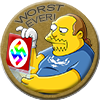The Fast Food Thread
- Thread starter Eonan
- Start date
You are using an out of date browser. It may not display this or other websites correctly.
You should upgrade or use an alternative browser.
You should upgrade or use an alternative browser.
The Ancient_sl
shitlord
- 7,386
- 16
I got some chocolate covered bacon as a gift once. Maybe it was just the quality of the product, but shit was terrible.Some people say bacon is overplayed, but I haven't found anything yet that isn't improved by adding bacon. I'm gonna try putting bacon in oatmeal someday.
Itlan
Blackwing Lair Raider
- 4,994
- 744
I get roast beef with bacon and cheddar at our work's deli all the time. Its good shit.I love all the components - but bacon on roast beef seems wrong.
Lanx
<Prior Amod>
yea it was probably terrible, bacon's natural saltiness tends to accentuate chocolate, you'll always see some kind of bacon flavored cupcake at your bakery, if not... well you need to find a better baker!I got some chocolate covered bacon as a gift once. Maybe it was just the quality of the product, but shit was terrible.
For some reason it has become a thing with my friends that every time any of them sees some odd bacon product, they buy it for me. I can tell you with certainty, there are things that are not enhanced by bacon. Bacon soda (pop) was absolutely disgusting.

Bacon mints are equally disgusting.


Bacon mints are equally disgusting.

chthonic-anemos
bitchute.com/video/EvyOjOORbg5l/
It's amazing that they needed an advertising guru to move bacon via some bs about health benefits.
Bacon facts:
Bacon facts:
Bacon?s association with the American breakfast is barely a century old. Before this, the majority of Americans ate more modest, often meatless breakfasts that might include fruit, a grain porridge (oat, wheat or corn meals) or a roll, and usually a cup of coffee.
So how did bacon become associated with the American breakfast? Let me introduce you to the grand-daddy of public relations and advertising, Mr. Edward Bernays.
The Austrian-born Bernays was the nephew of Sigmund Freud, and was quite good at using psychology to get people to buy a product or an idea. He was the guy who was hired by the Aluminum Company of America to use the American Dental Association to convince people that water flouridation was safe and healthy to the public. His campaign for Dixie Cups scared people into thinking the glasses they were drinking out of were unsanitary, and could be replaced by disposable cups. Bernays was hired by President Coolidge to help run his re-election campaign in 1924, and encouraged Coolidge to invite the country?s leading vaudevillians to the White House for a meet-and-greet over pancakes. This was one of the first known political pancake breakfasts that are now so popular among presidents and council members alike.
In the 1920s, Bernays was approached by the Beech-Nut Packing Company ? producers of everything from pork products to the nostalgic Beech-Nut bubble gum. Beech-Nut wanted to increase consumer demand for bacon. Bernays turned to his agency?s internal doctor and asked him whether a heavier breakfast might be more beneficial for the American public. Knowing which way his bread was buttered, the doctor confirmed Bernays suspicion and wrote to five thousand of his doctors friends asking them to confirm it as well. This ?study? of doctors encouraging the American public to eat a heavier breakfast ? namely ?Bacon and Eggs? ? was published in major newspapers and magazines of the time to great success. Beech-Nut?s profits rose sharply thanks to Bernays and his team of medical professionals.
Bacon is basically the diamonds of breakfast food. I wonder if that means Tuco eats imitation bacon for breakfast and says its just as good?It's amazing that they needed an advertising guru to move bacon via some bs about health benefits.
Bacon facts:
Royal
Connoisseur of Exotic Pictures
Randolph knew those margins on pork belly futures wouldn't grow themselves.It's amazing that they needed an advertising guru to move bacon via some bs about health benefits.
Bacon facts:

Noodleface
A Mod Real Quick
Bacon soda is one of those things you leave bottled and put on display so people can get a chuckle out of it. Nothing is more sacred to me than soda.
Royal
Connoisseur of Exotic Pictures
Namely because you have to know that no part of it ever crossed paths with any part of a pig.Bacon soda is one of those things you leave bottled and put on display so people can get a chuckle out of it.
No part that you would want to put in your mouth at least.
Yeah you must have some shitty buffets, if you think Panda Express is good.Panda Express is better than any Chinese buffet I've had, but worse than most any takeout place. The area I am in has shit for good Chinese places so it's the best option if I want Chinese for lunch or something.
That shit is just inedible. It is the worst Chinese food Ive ever had in my life. I'm not sure how it's in the buisness, the ones by me never have people at them.
Share:









